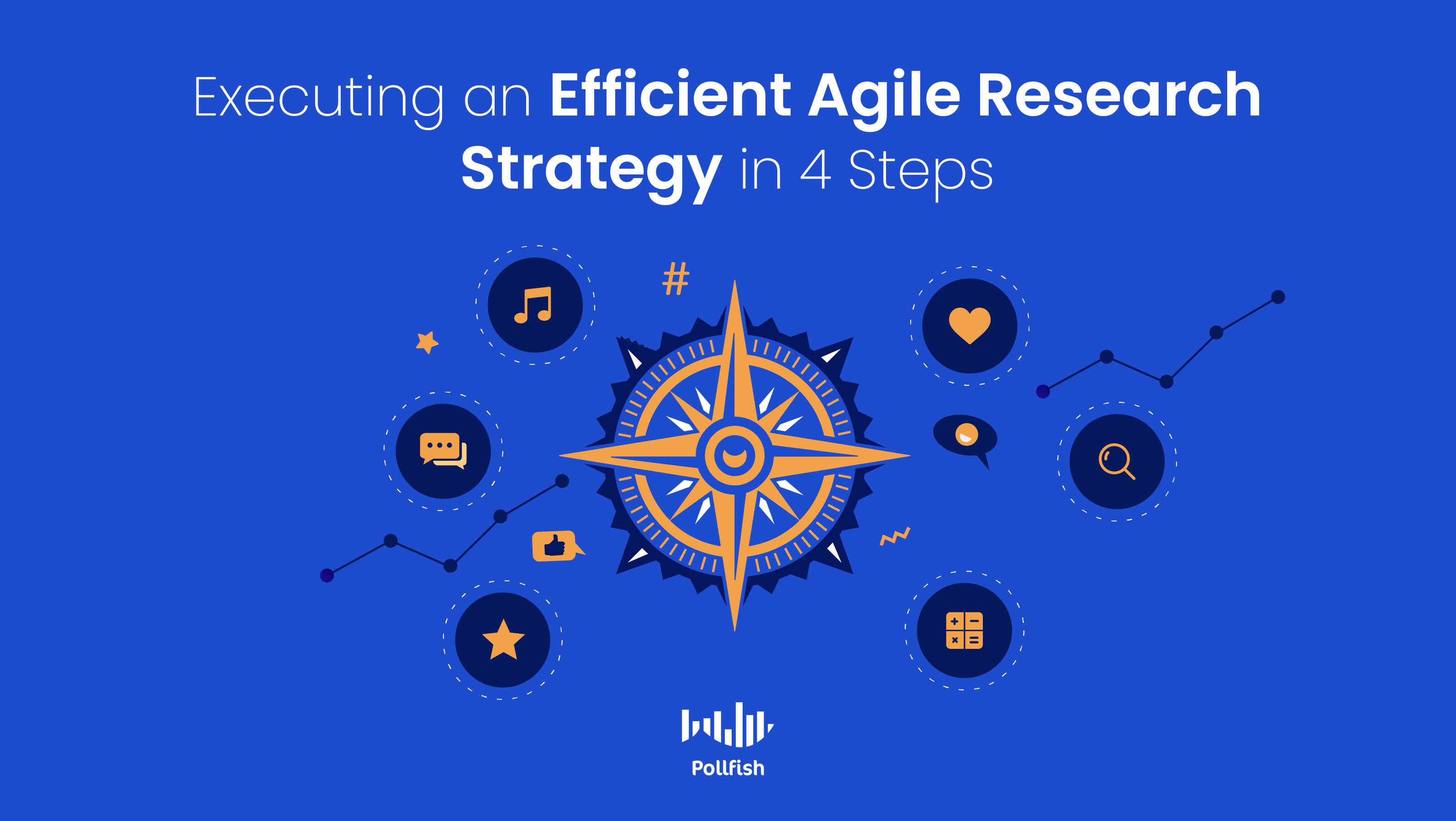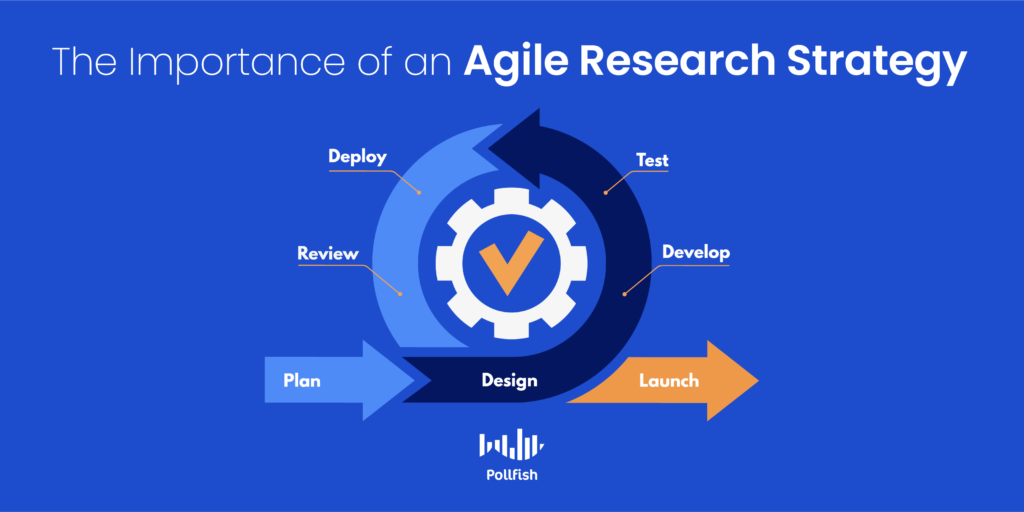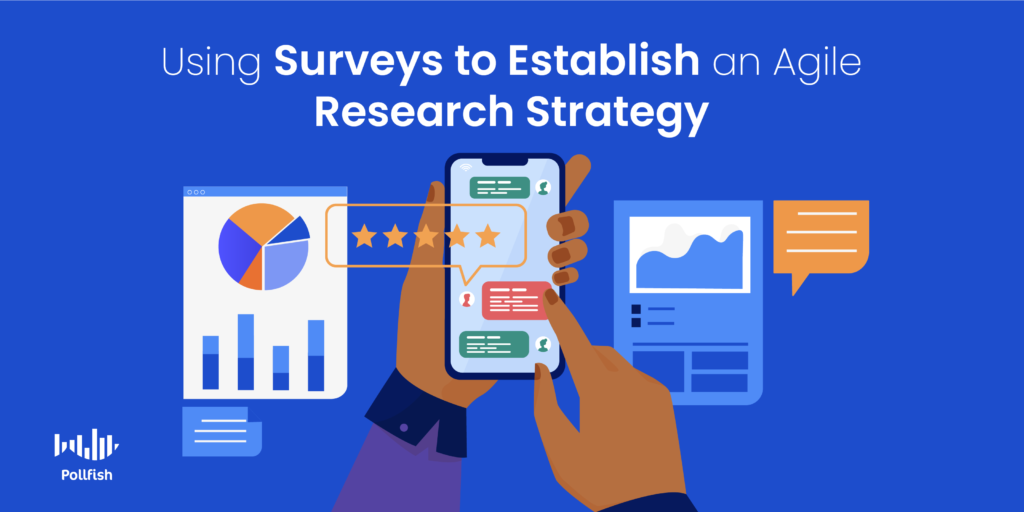How to Execute an Efficient Agile Research Strategy with 4 Steps

Executing an agile research strategy goes far beyond working quickly. Rather, it involves agile software development methods, along with following several best practices. Coupling these key aspects allows businesses to become well-suited to performing agile research.
Becoming a truly agile organization has a powerful impact across departments, even affecting business expenditures. In fact, a Harvard study found that by the end of the agile transition, CEOs spend four times the amount of time on research strategy, at 10% – 40%.
93% of businesses that had fully adopted an agile research strategy before the COVID-19 pandemic outperformed businesses that hadn’t. Clearly, using an agile research strategy is a key component of business operations and success.
This article explains the meaning behind the agile research strategy, its importance, benefits, how to execute it efficiently with four steps, and how surveys are the best bet for software development methods.
Understanding Agile Research Strategy
Agile research strategy is a four-step strategy that falls under agile market research, an approach characterized by accelerating market research operations and processes to ensure timely and efficient results.
There are several best practices that make up this strategy. Since it falls under agile market research, these strategies also involve using agile software and development methods that are iterative in nature.
The iterative approach involves taking small steps towards an end goal, where each step informs the next and involves iterating tests, as opposed to the waterfall approach, which involves completing a project in one go.
The agile research strategy builds off of this iterative approach and can be used in the strategic planning process. In order to truly be agile, this strategy requires coupling on-demand technology with a four-step iterative process.
The Importance of the Agile Research Strategy

Having an agile research strategy is important on many fronts. First and foremost, it is one of the major aspects that uphold agile market research, working in tandem with the agile technology that helps bring any research campaign to completion.
Secondly, this kind of strategy allows researchers and their business at large, to work much faster and become more productive. This is because the agile method relies heavily on using AI and automation market research platforms, the kinds that remove manual, repetitive work from the research process.
It’s also because the strategy involves a great deal of planning, testing, and understanding customers and other research subjects down to a T, as the following section explains.
This strategy allows businesses to perfect a variety of business campaigns, and to do so in an informed and data-backed manner. The agile research strategy works to improve everything from branding and brand visibility to concept testing and customer development.
Essentially, this strategy underpins and strengthens all the processes that are involved in various business campaigns — marketing or otherwise. It helps researchers and other team members better work together, as it typically involves collaborations across departments to reach alignment across goals.
In this way, it brings the democratization of data into play, meaning that all team members can work with data, even those who are non-technical. This is because each step in the strategy is methodical and one designed to help teams conduct and use market research better.
4 Tips on Best Practices for Agile Research Strategy
Brands can execute an informed agile research strategy by adhering to four stages, or steps. This section examines each of these four stages individually, what to do in each, and how these steps ensure quality results.
Foundational Learning
The first stage in the four-step strategy, foundational learning is used for building a strong foundation for the rest of the process. Brands build the foundation via compiling the needs of their target market. This includes their demographics, psychographics, desires, and needs.
Businesses must study their customers directly to obtain this data. They can do so by conducting a focus group, survey panel, or consumer survey. Brands must use the proper market research software or technology to be agile, as these methods can be increasingly time-consuming and difficult to perform in traditional ways.
However a business chooses to construct market research, it should ask questions that allow it to engage in foundational learning. As such, they should tap into areas such as demographics, brand awareness, customer behavior, preferences, and much more.
Businesses can get access to these insights with both qualitative and quantitative market research but must rely on an agile market research platform to deliver these insights.
Innovation Pipeline
The innovation pipeline stage deals with business strategy. This stage should apply the information that businesses garnered from the foundational learning step and apply it across various market research and marketing campaigns.
For example, businesses can use the data they reaped from the first step and use it to build customer personas, tweak their marketing messages, tailor products and innovate on product features, along with broadly connecting with their target market by addressing their needs or speaking with them via representatives.
To do so, brands should identify all kinds of customer behaviors to understand category opportunities and their consumers’ unmet needs. They should continue studying their customers’ unique needs at a more granular level, such as with follow-up studies.
Product testing is another crucial element in this stage, as it is still early in the process and the most important iterations occur from survey responses on product ideas and sentiment. Doing so allows businesses to go to market with more confidence that their products meet their consumer needs.
Brands should also validate iterations against competitors’ products, as it will give them a competitive advantage.
When a business reaches parity or superiority in its benchmarks, and consumers detect it, the business will be in a sweet spot and can proceed to develop its campaigns.
Campaign Development
This stage involves developing marketing campaigns supported by strategic research in order to form brand equity, foster awareness, and drive demand. It shows that a good product is not enough to succeed.
Much like creating innovative products, businesses should rely on market research in this step, incorporating things like user panels, foundational learning, iterative tactics, alongside qualitative and quantitative research.
After businesses create campaign ideas based on their target market comprehension, they can test new ads with their consumers. The feedback from this activity is used to iterate and conduct tests. This allows businesses to fine-tune their campaigns and their corresponding messaging, and branding. By iterating and testing, brands can understand the effectiveness of their copy, imagery, and more.
Businesses should continue this work until their benchmarks are outperformed and campaigns are ready to go to market.
Shopper/ Tracking Support
While campaign development is a crucial step in the agile research strategy, it is not the final one. This is because markets and consumers are constantly evolving; businesses ought to remain agile and attentive to sustain a competitive advantage.
As such, there is work to be done after products are tested, iterated, and launched along with their marketing campaigns.
In this final stage, brands should evaluate their shopper and customer support experience. This involves studying the in-store experience, customer interactions with personnel, including those that offer support, along with studying retail assets.
This step is partially used to make forecasts on current markets to ensure effective future campaigns. Although it is impossible to precisely predict markets, businesses can still make accurate predictions by following this four-step strategy. But they must carry out these stages using the correct market research software, the kind that provides agile data.
How Surveys Complement Agile Research Strategy

Given that the majority of agile research strategy involves iteration and testing, surveys — particularly online surveys — are crucial and trustworthy tools to use. They enable brands to extract virtually any kind of customer opinion, sentiment, or need.
This is because surveys allow brands to ask any question and deploy the questionnaire to their target audience. Businesses can use surveys for any campaign, from branding and general marketing to product strategy, and customer experience evaluation. Some online survey platforms even allow market researchers to A/B test concepts concurrently with their surveys.
As such, researchers can iterate concepts with surveys on hand. If customers respond negatively or less enthusiastically than expected to on a concept, a business can test another one by simply deploying another survey.
Surveys can also be used to better understand the overall shopping experience, as described in the final step, as brands can deploy surveys that address their own CX. All in all, surveys can be applied to a variety of campaigns, including pre and post-campaign market research, allowing brands to establish an efficient agile research strategy.
Making Headway in Agile Research
Agile market research is no longer a buzzword, despite the fact that not everyone shares the same definition of it and applies it to slightly different areas of research, along with different objectives.
To reiterate, agile market research is the application of agile software methods (think iterative activities with market research practices, such as the agile research strategy. This strategy dictates how to test, iterate, and launch products, concepts, and campaigns more efficiently and quickly via a customer-centric approach.
In order to facilitate a strong agile research strategy, brands must use an agile market research platform. An online survey platform is brands’ and market researchers’ best bet, as it allows for customer targeting, survey creation, deployment, and post-results data filtering.
A strong online survey platform should obtain high-quality data, which can be executed with the RDE (random device engagement) sampling method. This method engages customers in their natural digital environments in a completely randomized way.
Such a platform must also rely on artificial intelligence to perform quality checks that ensure that brands extract only the highest quality of customer data. These checks should disqualify VPN users, gibberish answers, incomplete surveys, and other sources of poor data from appearing in the final survey results.
When a business uses such an online survey platform, it can seamlessly perform an agile research strategy.
admin
Ready to Try Pollfish?
Create your survey with AI, target high-quality respondents starting at $0.95 per complete, and start getting results in just minutes in real-time. From running a simple product concept survey to managing a constant stream of trackers for dozens of clients in dozens of countries, we’ve got you.
